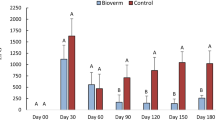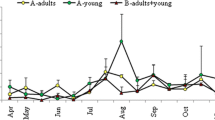Abstract
A field trial, conducted over two consecutive years, was aimed at assessing the efficacy of the administration of spores of the nematophagous fungus Duddingtonia flagrans to young goats for the control of nematode parasite infections on a French commercial dairy goat flock. For both years, the first-year grazing kids were divided into two similarly managed groups (fungus and control groups): in 2003 a daily dose rate of 5 × 105 spores/kg body weight was given to the fungus-group animals, while in 2004 a daily dose rate of 106 spores/kg body weight was used; the other half of the kids, acting as control, did not receive the spores. Parameters measured every 3 weeks included nematode egg excretion, larval development in faecal cultures and pasture larval counts. Additionally, at the beginning, the middle and the end of each grazing season, the goats were weighed and blood samples for pepsinogen determination were collected. In 2003, similar results were recorded for all the measured parameters in the control and fungus groups. In contrast, in 2004, the kids receiving the spores showed lower faecal egg counts and pepsinogen levels at the end of the season and higher growth rate compared to kids of the control group.
Similar content being viewed by others
Abbreviations
- epg:
-
eggs per gram of faeces
- lpg:
-
larvae per gram of faeces
- FEC:
-
faecal egg count
References
Chartier, C., Pors, I., Hubert, J., Rocheteau, D., Benoit, C. and Bernard, N., 1998. Prevalence of anthelmintic resistant nematodes in sheep and goats in Western France. Small Ruminant Research, 29, 33–41
Chartier, C., Soubirac, F., Pors, I., Silvestre, A., Hubert, J., Couquet, C. and Cabaret, J., 2001. Prevalence of anthelmintic resistance in gastrointestinal nematodes of dairy goats under extensive management conditions in southwestern France. Journal of Helminthology, 75, 325–330
Chartier, C. and Pors, I., 2003. Effect of the nematophagous fungus, Duddingtonia flagrans, on the larval development of goat parasitic nematodes: a plot study. Veterinary Research, 34, 221–230
Dimander, S.O., Höglund, J., Uggla, A., Spörndly, E. and Waller, P.J., 2003. Evaluation of gastrointestinal nematode parasite control strategies for first-season grazing cattle in Sweden. Veterinary Parasitology, 111, 193–209
Eysker, M. and Kooyman, F.N.J., 1993. Notes on necropsy and herbage processing techniques for gastrointestinal nematodes of ruminants. Veterinary Parasitology, 46, 205–213
Fernández, A.S., Larsen, M., Henningsen, E., Nansen, P., Grønvold, J., Bjørn, H. and Wolstrup, J., 1999a. Effect of Duddingtonia flagrans against Ostertagia ostertagi in cattle grazing at different stocking rates. Parasitology, 119, 105–111
Fernández, A.S., Larsen, M., Wolstrup, J., Grønvold, J., Nansen, P. and Bjørn, H., 1999b. Growth rate and trapping efficacy of nematode-trapping fungi under constant and fluctuating temperatures. Parasitology Research, 85, 661–668
Githigia, S.M., Thamsborg, S.M., Larsen, M., Kyvsgaard, N.C. and Nansen, P., 1997. The preventive effect of the fungus Duddingtonia flagrans on trichostrongyle infections of lambs on pasture. International Journal for Parasitology, 27, 931–939
Grønvold, J., Nansen, P., Henriksen, S.A., Larsen, M., Wolstrup, J., Bresciani, J., Rawat, H. and Fribert, L., 1996. Induction of traps by Ostertagia ostertagi larvae, chlamydospore production and growth rate in the nematode-trapping fungus Duddingtonia flagrans. Journal of Helminthology, 70, 291–297
Gruner, L. and Raynaud, J.-P., 1980. Technique de prélèvements d’herbe et de numération pour juger de l’infestation des paturages de bovins par des larves de nâmatodes parasites. Revue de Médecine Vétérinaire, 131, 521–529
Hoste, H. and Chartier, C., 1993. Comparison of the effects on milk production of concurrent infection with Haemonchus contortus and Trichostrongylus colubriformis in high- and low-producing dairy goats. American Journal of Veterinary Research, 54, 1886–1893
Kerboeuf, D., 1975. Le dosage du pepsinogène sanguine. Pfizer Actualités, 65, 9–16
Knox, M.R. and Faedo, M., 2001. Biological control of field infections of nematode parasites of young sheep with Duddingtonia flagrans and effects of spore intake on efficacy. Veterinary Parasitology, 101, 155–160
Larsen, M., 2000. Prospects for controlling animal parasitic nematodes by predacious micro fungi. Parasitology, 120, S121–S131
Morgan, M., Behnke, J.M., Lucas, J.A. and Peberdy, J.F., 1997. In vitro assessment of the influence of nutrition, temperature and larval density on trapping of the infective larvae Heligmosomoides polygyrus by Arthrobotrys oligospora, Duddingtonia flagrans and Monacrosporium megalosporum. Parasitology, 115, 303–310
Paraud, C. and Chartier, C., 2003. Biological control of infective larvae of a gastro-intestinal nematode (Teladorsagia circumcincta) and a small lungworm (Muellerius capillaris) by Duddingtonia flagrans in goat faeces. Parasitology Research, 89, 102–106
Paraud, C., Hoste, H., Lefrileux, Y., Pommaret, A., Paolini, V., Pors, I. and Chartier, C., 2005. Administration of Duddingtonia flagrans chlamydospores to goats to control gastro-intestinal nematodes: dose trials. Veterinary Research, 36, 157–166
Raynaud, J.P., 1970. Etude de l’efficacité d’une technique de coproscopie quantitative pour le diagnostic de routine et le contrôle des infestations parasitaires des bovins, ovins, équins et porcins. Annales de Parasitologie Humaine et Comparée, 45, 321–342
Šarkũnas, M., Larsen, M., Nansen, P. and Hansen, J.W., 2000. Biological control of trichostrongylid infections in calves on pasture in Lithuania using Duddingtonia flagrans, a nematode-trapping fungus. Journal of Helminthology, 74, 355–359
Terrill, T.H., Larsen, M., Samples, O., Husted, S., Miller, J.E., Kaplan, R.M. and Gelaye, S., 2004. Capability of the nematode-trapping fungus Duddingtonia flagrans to reduce infective larvae of gastrointestinal nematodes in goat feces in the southeastern United States: dose titration and dose time interval studies. Veterinary Parasitology, 120, 285–296
Thamsborg, S.M., Roepstorff, A. and Larsen, M., 1999. Integrated and biological control of parasites in organic and conventional production systems. Veterinary Parasitology, 84, 169–186
Waghorn, T.S., Leathwick, D.M., Chen, L.Y. and Skipp, R.A., 2003. Efficacy of the nematode-trapping fungus Duddingtonia flagrans against three species of gastro-intestinal nematodes in laboratory faecal cultures from sheep and goats. Veterinary Parasitology, 118, 227–234
Waller, P.J., Faedo, M. and Ellis, K., 2001. The potential of nematophagous fungi to control the free-living stages of nematode parasites of sheep: towards the development of a fungal controlled release device. Veterinary Parasitology, 102, 299–308
Waller, P.J., Schwan, O., Ljungström, B.L., Rydzik, A. and Yeates, G.W., 2004. Evaluation of biological control of sheep parasites using Duddingtonia flagrans under commercial farming conditions on the island of Gotland, Sweden. Veterinary Parasitology, 126, 299–315
Wright, D.A., McAnulty, R.W., Noonan, M.J. and Stankiewicz, 2003. The effect of Duddingtonia flagrans on trichostrongyle infections of Saanen goats on pasture. Veterinary Parasitology, 118, 61–69
Author information
Authors and Affiliations
Corresponding author
Rights and permissions
About this article
Cite this article
Paraud, C., Pors, I. & Chartier, C. Efficiency of feeding Duddingtonia flagrans chlamydospores to control nematode parasites of first-season grazing goats in France. Vet Res Commun 31, 305–315 (2007). https://doi.org/10.1007/s11259-006-3467-1
Accepted:
Published:
Issue Date:
DOI: https://doi.org/10.1007/s11259-006-3467-1




